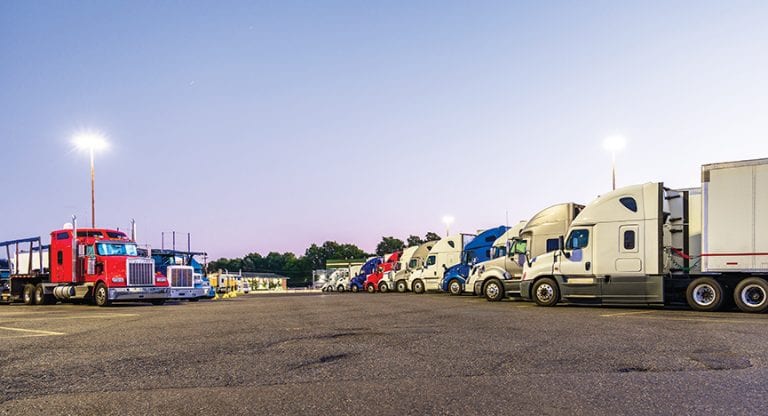For the National Coalition of Truck Parking, the end of 2020 brought the end of an assessment ordered by Jason’s Law.
Jason’s Law, adopted in 2012, is named for the late Jason Rivenburg, who was murdered during a robbery in 2009 after being unable to find safe parking. Ahead of schedule on his deliveries to South Carolina, Rivenburg had to find a place to park overnight, and knew a nearby abandoned gas station could be used for parking. It was the last parking decision he ever made.
The National Coalition on Truck Parking, which includes stakeholders from the public sector, transportation organizations, the freight industry and other groups, overviewed the heart of the problem in Rivenburg’s murder — truck parking shortages.
The 2020 Jason’s Law survey revealed that 98% of truck drivers report problems in finding safe parking. Since the law was enacted, the survey has been conducted by the U.S. Department of Transportation’s Federal Highway Administration (FHWA).
There are currently 313,000 truck parking spaces in the U.S., with 40,000 at public rest stops and 273,000 at private rest stops, according to the 2020 FHWA report.
The coalition found there are not many new facilities or parking spaces being developed, with challenges in planning, funding and accommodations. Also, based on the freight analysis framework from the FHWA, freight activity in the U.S. is estimated to grow about 40% in tonnage in the next 30 years.
With this in mind, the U.S. House of Representatives has introduced legislation to fund up to $755 million to help states finance projects that would increase the nation’s number of truck parking spaces.
It’s not clear when or if this legislation — known as H.R. 6104, or the Truck Parking Safety Improvement Act — will pass. However, trucking associations and groups such as the National Motorists Association, the Institute for Safer Trucking and others, have been quick to support the bill.
In the meantime, state department of transportations, as well as businesses, are working to increase parking options for trucks.
Businesses address parking shortage
To help alleviate the parking shortage, designated truck stops such as Love’s Travel Stops, TravelCenters of America (TA) and Pilot Flying J Centers are opening new locations and new truck parking spaces in 2021. Combined, these truck stop chains are planning to add approximately 5,600 locations this year.
TA, which operates TA, Petro Stopping Centers and TA Express stores, plans to open 20 new locations this year with an approximate combined total of 2,000 truck parking spaces.
“Providing a safe haven for drivers is part of who we are,” said Tina Arundel, communications director for TA. “It’s important to TA that reliable parking options are available at our sites because professional drivers rely on us for so much more than just a place to stop their clock for the night.”
Last year TA opened 10 new locations, adding about 700 parking spaces. In January 2021, TA added a travel center in Huntington, Oregon, that brought 150 truck parking spaces to the area.
According to Arundel, challenges associated with creating additional truck parking when opening a new store are due to construction considerations.
“In regard to design of truck parking, width, angle and overall orientation of the spaces is crucial to facilitate easy parking,” she said. “Ample, bright lighting on the lot is extremely important from a safety perspective, and we also strive to have our travel center in close proximity to the parking spaces, so drivers can easily access our services.”
Another prominent truck stop chain, Pilot Flying J, is working on new upgrades and locations to become more consistent.
“In 2021, we are planning to build more than 15 new locations, add approximately 600 parking spaces to the industry and are targeting to upgrade and reimage more than 150 existing locations to provide drivers with more locations and a great guest experience,” according to a statement from Pilot Co.
Love’s Travel Stops added 3,000 spaces in 2020 and continues to add new locations with more parking. As of February 2021, Love’s has already opened 335 truck parking spaces, with 300 additional spaces to be opened near the end of March. A total of 50 new Love’s locations with more than 3,000 parking spaces are planned in 2021.
“Because Love’s offers free parking at all locations, we do see lots at full capacity,” said Rick Shuffield, vice president of real estate for Love’s. “In 2020, we added more than 3,000 truck parking spaces across the country and plan to add the same amount in 2021. Love’s will continue to add spaces to serve its core customer, the professional truck driver.”
In addition to other concerns when breaking ground on a new location, space constraints can be challenges, dictating the number of spaces that can be included along with a new location.
“Sometimes space constraints prevent us from adding as many parking spaces as we’d like,” Shuffield said. “One of the most important things is providing enough space for professional drivers to safely turn their trucks into and out of the parking lots.”
In addition to parking spaces being added by truck stops, there are technological advances that allow drivers to find other safe parking options.
Anthony Petitte, CEO of TruckPark, said his business is a marketplace between partnered operators to help drivers find safe parking. The TruckPark app helps drivers find and reserve parking spaces before reaching their destination.
Petitte said TruckPark’s goal is to have as many locations and parking spaces as possible.
“The more parking facilities you onboard is how you control the market,” he said. “The biggest challenge is getting the operators on board and them understanding that this market is predicated. We [have to make sure] that drivers are safe and secure and not endangered.”
In total, the TruckPark network includes 42,000 truck parking spaces in 265 locations in the U.S. and Canada, according to Petitte. On average, a partnered TruckPark facility has 250 parking spaces. TruckPark partners include DAT, FourKites and Nexar.
TruckPark locations offer fenced perimeters and guards to watch the facilities. In some cases, there are automatic gate codes or industrial locks drivers can use. The bottom line is that each location TruckPark partners with has security cameras and fences, according to Petitte.
A problem he has noticed is that industrial parking facilities are in high crime areas without safety measures. When working with partners for new locations, Petitte said he has to find operators who are willing to have secure facilities.
“Putting in an extra $5,000 to $10,000 in capital to build a fence around your site is going to be an absolute killer for your drivers,” he said. “If they have a good experience and feel safe, they’re going to come back.”
Government agencies address the issue
Private businesses are not the only entities working to create more safe truck parking. Some state governments are also making truck parking a priority. Iowa and Wyoming, for example, are constructing new rest areas and parking spaces for truck drivers.
As a part of its master plan, the Wyoming Department of Transportation (WYDOT) is adding parking spaces and climbing lanes along Interstate 80.
The project will add nearly 100 new truck parking spaces to two sites along I-80, bringing the total number of spaces at the two locations to nearly 200. The Fort Steele rest area is about 7 miles east of Sinclair, Wyoming, at mile marker 228, and the Quealy Dome truck parking area is 20 miles west of Laramie, Wyoming, at mile marker 290.
“We wanted to add the truck parking because there was a need,” said Keith Fulton, chief engineer for WYDOT. “There’s a lot of trucks that cross I-80. About 50% of the traffic, for us, is trucks, so we knew we had to have an area for them.”
In addition to parking spaces, signs noting the number of available spaces will be added, along with roadside radio installations that communicate current weather conditions on the highway. That way, truck drivers can prepare for any potential inclement weather and can find spaces despite fog, or a snowstorm.
Two truck climbing lanes, each 2 miles long, will be added on I-80, according to Keith Fulton, chief engineer for WYDOT. The climbing lanes will allow slow-moving vehicles to break up traffic on the interstate’s steep slopes.
“On our steeper slopes, in the past, we’ve seen trucks that have had trouble or slowed down trying to get up the hill, especially in inclement weather,” Fulton said. “We wanted to add that additional lane so vehicles are safer and to keep traffic moving.”
The bulk of the construction is to start this spring, with the completion of parking spaces expected in October 2022.
The Iowa Department of Transportation has been working on a rest area management plan since 2012, and released the final plan in August 2020. The plan includes upgrading buildings and expanding truck parking at 12 aging full-service rest areas beginning in 2022, with a projected completion date of 2033. Rest areas are considered “aging” when the sites are close to 50 years or older.
Six parking-only sites in Iowa will receive additional truck parking spaces, and eight rest areas will close, according to the final version of the plan. In total, the plan will create approximately 247 additional truck parking spaces, a 30% increase for Iowa. However, implementation of the plan may not happen soon.
“It’s a long-term thing,” said Bryan Bradley, deputy director for the location and environment bureau for the Iowa DOT. “One of our goals is to not take out more spots than we’re adding, so that we’ll always be net positive. We have it all laid out in a plan right now, but it has got to be fluid.”
Bradley noted the financial aspect of these modifications is the top issue in implementing the rest area management plan — the upgrades to 12 full-service rest areas will cost approximately $7.2 million.
“Our funding can be very fluid,” Bradley said. “To put a plan that’s long term [in place] when you’re unsure of your finances — because it costs money to shut them down, it costs money to build them, or to refurbish — funding is a big consideration.”
Iowa’s rest area management plan also calls for the closure of 10 small parking-only sites that offer less than six truck parking spots each. Cumulative savings of program and operations for closures is approximately $38.2 million. The first draft of the plan proposed closing 11 of the state’s 38 full service rest area stations and all 16 of its parking-only sites.
“The response to this wasn’t great, and we listened,” an August 2020 report from the Iowa DOT stated. “The public comments we received after the initial release convinced us that we needed to take a closer look, particularly at truck parking, which was identified as an issue in the majority of comments received.”
The agency shifted, conducting freight truck parking and public input studies, and released a final report available at iowadot.gov.
The FHWA does offer the Fixing America’s Surface Transportation (FAST) Act to provide long-term funding efforts for infrastructure planning and development. Former president Donald Trump extended the FAST Act in Oct. 2020, with an additional $13.6 billion added to the nation’s Highway Trust Fund.
Initially signed into law by President Barack Obama, the act ensures long-term funding for surface transportation programs to improve highways and ease congestion on the nation’s interstate system and major roads.
“The FAST Act provided a new freight-specific category, which constituted new money for the states that they could theoretically program for truck parking in addition to other projects,” a spokesperson from the FHWA said. The act also provides grants programs that are eligible to be used for truck parking spaces.
“Truck parking shortages are a national safety concern,” according to the FHWA’s freight management and operations website. “An inadequate supply of truck parking spaces can result in two negative consequences: First, tired truck drivers may continue to drive because they have difficulty finding a place to park for rest and, second, truck drivers may choose to park at unsafe locations, such as on the shoulder of the road, exit ramps or vacant lots, if they are unable to locate official, available parking.”
The FHWA has conducted numerous studies to find a way to provide sufficient truck parking. According to the agency’s website, the studies have common results — there has been a growth in truck activity with shortages of truck parking. The results find a lack of information on how to create spaces as well as challenges in rest requirements.
Hannah Butler is a lover of interesting people, places, photos and the written word. Butler is a former community newspaper reporter and editor for Arkansas Tech University’s student newspaper. Butler is currently finishing up her undergraduate print journalism degree and hopes to pursue higher education. Her work has been featured in at least nine different publications.
















A lot of parking issues would be resolved in major distribution centers like Target, Wal-Mart, Publix etc were made to allow truckers parking. Then it would be up to the drivers to keep the truck lot clean. (No urine bottles or trash bags thrown out on the lot.)
Ta , and pilot are the worst , they don’t keep up with making sure the reserved spots are clearly marked , some have no paint at all and if park thinking it’s not reserved they’ll call the police . it’s unprofessional and sad how they rip off hard working good people